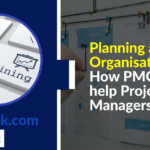The Enterprise Project Management Office (EPMO) operates at the strategic level of an organisation, working closely with executives to ensure that project activity aligns with the overall strategic goals and provides benefit to the organisation as a whole.
It works on a company-wide basis, providing guidance, governance and best practices, and standardising processes.
EPMO Vs PMO
So how does the EPMO differ from the traditional PMO, and how does an organisation decide whether to make the transition?
PMO’s typically manage specific projects and deliverables that are seldom linked with the organisation’s objectives. In the modern business environment effectiveness is increasingly measured by the closeness of the PMO to the organisation’s overall success, and so EPMOs have gained popularity.
EPMOs have all of the same responsibilities as a PMO in terms of setting direction and maintaining and ensuring standards and best practices. They also however, have an additional responsibility of aligning project, program and portfolio activities with the organisation’s strategic objectives.
The EMPO is used over a PMO where an organisation has:
- Projects of high-complexity.
- Multiple, simultaneously occurring projects.
- Multiple teams working on the same, or similar projects.
- A high proportion of failing projects.
- A growing portfolio.
Advantages of EPMO
Fewer failed projects
When projects are linked to the organisation’s strategy risk is reduced and fewer projects fail.
Streamlined projects
Restricting projects only to those which align with strategic objectives means that the organisation doesn’t take on too many projects at once.
Less duplication
In organisations where PMO’s operate individually there is often overlap and duplication between projects. Having a top-level overview of all proposed projects means that unnecessary projects can be eliminated.
Better use of resources
The top-level view of all proposed projects also helps in the effective utilisation of resources. Resources can be allocated to projects as appropriate, helping to reduce waste.
In addition to tangible resources, human resources can also be allocated to projects where their skills are best suited.
Improved methodology
The EPMO will decide upon one methodology and provide best practice to teams in its usage, helping to standardise the project process.
Disadvantages of EPMO
Staff buy-in
Resistance to change is natural, and particularly common when staff are forced to move away from the familiar status-quo, leading to a lack of support. If the benefits of moving to an EPMO are communicated clearly and staff feel supported, then this will facilitate the transition.
Standardisation
Whilst standardisation can be a good thing for an organisation who work on a multitude of projects, it can also pose a serious disadvantage.
All organisations and projects are complex, and can differ significantly, so it is important to remember that one size doesn’t fit all. Numerous methodologies exist within project management as each project needs its own specific set of tools, so to reject those in favour of one standard method may prove ineffective.
Low morale
The top-down overview of the EPMO is similar in structure to the waterfall approach to project management, which is often viewed as out-dated in an Agile world.
Proponents of Agile methodology may therefore feel alienated by this new approach, in addition to staff who have made the change from waterfall to Agile in recent times, leading to reduced morale.
When making the move from a PMO to an EPMO you should consider whether your organisation actually needs one. Are you dealing with large, complex projects? Do you work on multiple projects simultaneously? Are you finding duplication and overlap between your projects?
If the answer to those questions is yes, then an EPMO will greatly benefit your organisation if implemented properly. If the answer is no then you may want to consider remaining with a PMO and review this at regular intervals.
For more details on other types of PMO, please take a look at the post – Different names of a PMO.






